Coopetition as an Emerging Trend in Research: Perspectives for Safety & Security
Abstract
:1. Introduction
2. Through Coopetition Towards Safety & Security
3. Identification of Trends in Research and Perspectives of Coopetition for Safety & Security
3.1. Defining the Appropriate Search Terms
3.2. Initial Search Results
3.3. Data Statistics and Bibliometric Analysis
3.4. Network Analysis and its Visualization
3.5. Advanced Search and Content Analysis
- Joint software development projects performed via coopetition
- E-services and e-security provided by competitors through joint R&D
- Cyber-physical systems development within the global partnership in the context of Manufacturing Partnership (MP)
- Security challenges & knowledge and threat sharing paradox
- Security & safety standards development for coopetition alliances
- IT-solutions for coopetitive interactions
- Collaboration with agents and cooperation within multiagent systems
- Joint investments and joint start-ups in the context of Industry 4.0.
4. Discussion
5. Conclusions
Funding
Acknowledgments
Conflicts of Interest
Appendix A

| Cluster 1 (19 Items) | Cluster 2 | Cluster 3 | Cluster 4 | Cluster 5 | Cluster 6 | Cluster 7 |
|---|---|---|---|---|---|---|
| (14 Items) | (12 Items) | (12 Items) | (10 Items) | (6 Items) | (2 Items) | |
| co-opetition | business ecosystem | business model | competition | behavioral research | adaptive control system | paradox |
| commerce | business model | business modeling | competitiveness | decision making | bipartite consensus | tension |
| competition | cloud computing | case study | cooperation | design | coopetition networks | |
| costs | collaboration | coopetition | cooperative behavior | information analysis | multi agent systems | |
| dynamics | competitive advantage | industrial management | human | information sharing | multi-agent systems | |
| economics | ecology | innovation | humans | information systems | structural balance | |
| electronic commerce | ecosystems | knowledge | management | knowledge management | ||
| game theory | open source software | open innovation | marketing | knowledge sharing | ||
| industry | open systems | smes | sustainable development | knowledge-sharing | ||
| informational management | open-coopetition | strategy | tourism economics | modeling | ||
| optimization | social networking (online) | technology | tourist destination | |||
| planning | software design | value creation | trust | |||
| profitability | software engineering | |||||
| project management | strategic alliance | |||||
| sales | ||||||
| supply chain management | ||||||
| supply chains | ||||||
| wireless network | ||||||
| wireless telecommunication |
References
- Ostrower, J. What is the Boeing 737 Max Maneuvering Characteristics Augmentation System? The Air Current. 17 November 2018. Available online: https://theaircurrent.com/aviation-safety/what-is-the-boeing-737-max-maneuvering-characteristics-augmentation-system-mcas-jt610/ (accessed on 29 May 2019).
- Wichter, Z. What You Need to Know After Deadly Boeing 737 Max Crashes. New York Times. 24 May 2019. Available online: https://www.nytimes.com/interactive/2019/business/boeing-737-crashes.html (accessed on 29 May 2019).
- Campbell, D. Redline: The Many Human Errors that Brought down the Boeing 737 Max. The Verge. 9 May 2019. Available online: https://www.theverge.com/2019/5/2/18518176/boeing-737-max-crash-problems-human-error-mcas-faa (accessed on 29 May 2019).
- Isidore, C. Boeing’s Profit Falls 21% on the 737 Max Crisis. CNN Business. 24 April 2019. Available online: https://www.cnn.com/2019/04/24/investing/boeing-earnings/index.html (accessed on 29 May 2019).
- Genga, B.; Odeh, L. Boeing’s 737 Max Problems Put $600 Billion in Orders at Risk. Bloomberg. 19 March 2019. Available online: https://www.bloomberg.com/news/articles/2019-03-14/boeing-s-600-billion-in-max-orders-at-risk-as-airlines-retreat (accessed on 29 May 2019).
- Reuters. Boeing Records Zero New 737 MAX Orders Following Worldwide Groundings. South China Morning Post. 10 April 2019. Available online: https://www.scmp.com/news/world/united-states-canada/article/3005463/boeing-records-zero-new-737-max-orders-following (accessed on 29 May 2019).
- Baker, S. Qatar Airways is Joining the Growing Number of Airlines Demanding Payback from Boeing for Its 737 Max Disaster—Here’s the Full List. Business Insider. 7 June 2019. Available online: https://www.businessinsider.com/boeing-737-max-crisis-air-china-calling-for-compensation-2019-5 (accessed on 12 June 2019).
- Brandenburger, A.; Nalebuff, B. Co-Opetition, 1st ed.; Broadway Business: New York, NY, USA, 1996; 288p. [Google Scholar]
- Dagnino, G.B.; Di Guardo, M.C.; Padula, G. Coopetition: Nature, Challenges and Implications for Firms’ Strategic Behavior and Managerial Mindset. In Handbook of Research on Competitive Strategy; Dagnino, G.B., Ed.; Edward Elgar Publishing: Northamptom, MA, USA, 2012; pp. 492–511. [Google Scholar]
- Padula, G.; Dagnino, G.B. Untangling the rise of coopetition: The intrusion of competition in a cooperative game structure. Int. Stud. Mang. Org. 2007, 37, 32–52. [Google Scholar] [CrossRef]
- Czakon, W. Emerging coopetition: An empirical investigation of coopetition as inter-organizational relationship instability. In Coopetition: Winning Strategies for the 21st Century; Yami, S., Castaldo, S., Dagnino, G.B., Le Roy, F., Eds.; Edward Elgar Publishing: Northamptom, MA, USA, 2010; pp. 58–73. [Google Scholar]
- Bengtsson, M.; Kock, S. ”Coopetition” in business Networks—To cooperate and compete simultaneously. Ind. Market. Manag. 2000, 29, 411–426. [Google Scholar] [CrossRef]
- Bengtsson, M.; Kock, S. Coopetition—Quo vadis? Past accomplishments and future challenges. Ind. Market. Manag. 2014, 43, 180–188. [Google Scholar] [CrossRef]
- Le Roy, F. Rivaliser et coopérer avec ses concurrents: Le cas des stratégies collectives «agglomérées». Rev. Française Gest. 2003, 2, 145–157. [Google Scholar] [CrossRef]
- Le Roy, F.; Sanou, F.H. Does coopetition strategy improve market performance? An empirical study in mobile phone industry. J. Econ. Manag. 2014, 17, 64–92. [Google Scholar]
- Chiambaretto, P.; Dumez, H. Toward a typology of coopetition: A multilevel approach. Int. Stud. Mang. Org. 2016, 46, 110–129. [Google Scholar] [CrossRef]
- Fernandez, A.S.; Chiambaretto, P. Managing tensions related to information in coopetition. Ind. Market. Manag. 2016, 53, 66–76. [Google Scholar] [CrossRef]
- Perc, M.; Jordan, J.J.; Rand, D.G.; Wang, Z.; Boccaletti, S.; Szolnoki, A. Statistical physics of human cooperation. Phys. Rep. 2017, 687, 1–51. [Google Scholar] [CrossRef] [Green Version]
- Capraro, V.; Perc, M. Grand challenges in social physics: In pursuit of moral behavior. Front. Phys. 2018, 6, 107. [Google Scholar] [CrossRef]
- Ceptureanu, E.G.; Ceptureanu, S.I.; Olaru, M.; Bogdan, V.L. An exploratory study on coopetitive behavior in oil and gas distribution. Energies 2018, 11, 1234. [Google Scholar] [CrossRef]
- Ceptureanu, E.G.; Ceptureanu, S.I.; Radulescu, V.; Ionescu, S. What makes coopetition successful? An inter-organizational side analysis on Critical Success Factors in oil and gas distribution networks. Energies 2018, 11, 3447. [Google Scholar] [CrossRef]
- Leonov, S.V.; Vasylieva, T.A.; Tsyganyuk, D.L. Formalization of functional limitations in functioning of co-investment funds basing on comparative analysis of financial markets within FM CEEC. Actual Probl. Econ. 2012, 134, 75–85. [Google Scholar]
- Vasylieva, T.A. State and banks interaction in formation of national network of venture funds in Ukraine. Actual Probl. Econ. 2008, 82, 204–212. [Google Scholar]
- Bengtsson, M.; Eriksson, J.; Wincent, J. Coopetition: New ideas for a new paradigm. In Coopetition: Winning Strategies for the 21st Century; Yami, S., Castaldo, S., Dagnino, G.B., Le Roy, F., Eds.; Edward Elgar Publishing: Northamptom, MA, USA, 2010; pp. 19–39. [Google Scholar]
- Dorn, S.; Schweiger, B.; Albers, S. Levels, phases and themes of coopetition: A systematic literature review and research agenda. Eur. Manag. J. 2016, 34, 484–500. [Google Scholar] [CrossRef]
- Dahl, J. Conceptualizing coopetition as a process: An outline of change in cooperative and competitive interactions. Ind. Market. Manag. 2014, 43, 272–279. [Google Scholar] [CrossRef]
- Luo, Y. Toward coopetition within a multinational enterprise: A perspective from foreign subsidiaries. J. World Bus. 2005, 40, 71–90. [Google Scholar] [CrossRef]
- D’Aveni, R.A. Waking up to the new era of hypercompetition. Wash. Q. 1998, 21, 183–195. [Google Scholar] [CrossRef]
- Raza-Ullah, T.; Bengtsson, M.; Kock, S. The coopetition paradox and tension in coopetition at multiple levels. Ind. Market. Manag. 2014, 43, 189–198. [Google Scholar] [CrossRef]
- Stadtler, L.; Van Wassenhove, L.N. Coopetition as a paradox: Integrative approaches in a multi-company, cross-sector partnership. Organ. Stud. 2016, 37, 655–685. [Google Scholar] [CrossRef]
- De Araujo, D.V.B.; Franco, M. Trust-building mechanisms in a coopetition relationship: A case study design. Int. J. Organ. Anal. 2017, 25, 378–394. [Google Scholar]
- Eriksson, P.E. Procurement effects on coopetition in client-contractor relationships. J. Constr. Eng. Manag. 2008, 134, 103–111. [Google Scholar] [CrossRef]
- Gnyawali, D.R.; Park, B.J.R. Co-opetition between giants: Collaboration with competitors for technological innovation. Res. Policy 2011, 40, 650–663. [Google Scholar] [CrossRef]
- Osarenkhoe, A. A study of inter-firm dynamics between competition and cooperation—A coopetition strategy. J. Database Mark. Cust. Strategy Manag. 2010, 17, 201–221. [Google Scholar] [CrossRef]
- Bouncken, R.B.; Clauß, T.; Fredrich, V. Product innovation through coopetition in alliances: Singular or plural governance? Ind. Market. Manag. 2016, 53, 77–90. [Google Scholar] [CrossRef]
- Quintana-Garcia, C.; Benavides-Velasco, C.A. Cooperation, competition, and innovative capability: A panel data of European dedicated biotechnology firms. Technovation 2004, 24, 927–938. [Google Scholar] [CrossRef]
- Lee, C.-Y.; Wu, H.-L.; Pao, H.-W. How does R&D intensity influence firm explorativeness? Evidence of R&D active firms in four advanced countries. Technovation 2014, 34, 582–593. [Google Scholar]
- Czakon, W.; Mucha-Kuś, K. Coopetition research landscape—A systematic literature review 1997–2010. J. Econ. Manag. 2014, 17, 122–150. [Google Scholar]
- Fahimnia, B.; Sarkis, J.; Davarzani, H. Green supply chain management: A review and bibliometric analysis. Int. J. Prod. Econ. 2015, 162, 101–114. [Google Scholar] [CrossRef]
- Friedman, B.A.; Barnes, B.W. Client-server design provides model for ‘coopetition’ alliances. Comput. Healthc. 1992, 13, 38–39. [Google Scholar]
- Van Eck, N.J.; Waltman, L. VOSviewer Manual; Univeristeit Leiden: Leiden, The Netherlands, 2013; Available online: https://www.vosviewer.com/documentation/Manual_VOSviewer_1.6.10.pdf (accessed on 15 April 2019).
- Perianes-Rodriguez, A.; Waltman, L.; van Eck, N.J. Constructing bibliometric networks: A comparison between full and fractional counting. J. Informetr. 2016, 10, 1178–1195. [Google Scholar] [CrossRef] [Green Version]
- Van Eck, N.J.; Waltman, L. Citation-based clustering of publications using CitNetExplorer and VOSviewer. Scientometrics 2017, 111, 1053–1070. [Google Scholar] [CrossRef] [PubMed] [Green Version]
- Robinson-García, N.; Jiménez-Contreras, E.; Torres-Salinas, D. Analyzing data citation practices using the data citation index. J. Assoc. Inf. Sci. Technol. 2016, 67, 2964–2975. [Google Scholar] [CrossRef]
- Singh, V.K.; Atrey, P.K.; Kankanhalli, M.S. Coopetitive multimedia surveillance. In Proceedings of the International Conference on Multimedia Modeling MMM 2007 (Proceedings, Part II), Singapore, 9–12 January 2007; Springer: Berlin/Heidelberg, Germany, 2007; pp. 343–352. [Google Scholar]
- Singh, V.K.; Atrey, P.K. Coopetitive visual surveillance using model predictive control. In Proceedings of the Third ACM International Workshop on Video Surveillance Sensor Networks, Singapore, 11 November 2005; ACM: New York, NY, USA, 2005; pp. 149–158. [Google Scholar]
- Zrahia, A. Threat intelligence sharing between cybersecurity vendors: Network, dyadic, and agent views. J. Cybersecur. 2018, 4, 1–16. [Google Scholar] [CrossRef]
- Appan, R.; Bacic, D. Impact of Information Technology (IT) Security Information Sharing among Competing IT Firms on Firm’s Financial Performance: An Empirical Investigation. CAIS 2016, 39, 12. [Google Scholar] [CrossRef]
- Appan, R.; Bacic, D.; Madhavaram, S. Security Related Information Sharing among Firms: Potential Theoretical Explanations. In Proceedings of the Americas Conference on Information Systems 2018, New Orleans, LA, USA, 16–18 August 2018; Available online: https://aisel.aisnet.org/cgi/viewcontent.cgi?article=1404&context=amcis2018 (accessed on 15 July 2019).
- Gnyawali, D.R.; Madhavan, R.; He, J.; Bengtsson, M. The competition–cooperation paradox in inter-firm relationships: A conceptual framework. Ind. Market. Manag. 2016, 53, 7–18. [Google Scholar] [CrossRef]
- Yami, S.; Nemeh, A. Organizing coopetition for innovation: The case of wireless telecommunication sector in Europe. Ind. Market. Manag. 2014, 43, 250–260. [Google Scholar] [CrossRef]
- Bakshi, N.; Kleindorfer, P. Co-opetition and investment for supply-chain resilience. Prod. Oper. Manag. 2009, 18, 583–603. [Google Scholar] [CrossRef]
- Wang, L.; Törngren, M.; Onori, M. Current status and advancement of cyber-physical systems in manufacturing. J. Manuf. Syst. 2015, 37, 517–527. [Google Scholar] [CrossRef]
- About the Advanced Manufacturing Partnership 2.0. Available online: https://www.manufacturing.gov/programs/mforesight-alliance-manufacturing-foresight (accessed on 15 July 2019).
- Xu, L.D.; Xu, E.L.; Li, L. Industry 4.0: State of the art and future trends. Int. J. Prod. Res. 2018, 56, 2941–2962. [Google Scholar] [CrossRef]
- Moghaddam, M.; Nof, S.Y. The collaborative factory of the future. Int. J. Comput. Integr. Manuf. 2017, 30, 23–43. [Google Scholar]
- Lacity, M.C.; Khan, S.A.; Yan, A. Review of the Empirical Business Services Sourcing Literature: An Update and Future Directions. J. Inf. Technol. 2016, 31, 269–328. [Google Scholar] [CrossRef]
- Berti, G.; Mulligan, C. Competitiveness of Small Farms and Innovative Food Supply Chains: The Role of Food Hubs in Creating Sustainable Regional and Local Food Systems. Sustainability 2016, 8, 616. [Google Scholar] [CrossRef]
- Taghavi, M.; Bentahar, J.; Otrok, H.; Bakhtiyari, K. Cloudchain: A Blockchain-Based Coopetition Differential Game Model for Cloud Computing. In Proceedings of the International Conference on Service-Oriented Computing (ICSOC), Hangzhou, China, 12–15 November 2018; Springer: Cham, Switzerland, 2018; pp. 146–161. [Google Scholar]
- Kim, S.; Kim, S. A multi-criteria approach toward discovering killer IoT application in Korea. Technol. Forecast. Soc. Chang. 2016, 102, 143–155. [Google Scholar] [CrossRef]
- Fuggetta, A.; Di Nitto, E. Software process. In Proceedings of the on Future of Software Engineering (POSE), Hyderabad, India, 31 May–7 June 2014; ACM: New York, NY, USA, 2014; pp. 1–12. [Google Scholar]
- Khare, R.; Good, B.M.; Leaman, R.; Su, A.I.; Lu, Z. Crowdsourcing in biomedicine: Challenges and opportunities. Brief. Bioinform. 2015, 17, 23–32. [Google Scholar] [CrossRef] [PubMed]
- Busse, C. Doing Well by Doing Good? The Self-interest of Buying Firms and Sustainable Supply Chain Management. J. Supply Chain Manag. 2015, 52, 28–47. [Google Scholar] [CrossRef]
- Luciano, M.M.; DeChurch, L.A.; Mathieu, J.E. Multiteam Systems: A Structural Framework and Meso-Theory of System Functioning. J. Manag. 2015, 44, 1065–1096. [Google Scholar] [CrossRef] [Green Version]
- Brettel, M.; Friederichsen, N.; Keller, M.; Rosenberg, M. How virtualization, decentralization and network building change the manufacturing landscape: An Industry 4.0 Perspective. Int. J. Mech. Sci. Ind. Sci. Eng. 2014, 8, 37–44. [Google Scholar]
- Cetin, G.; Bilgihan, A. Components of cultural tourists’ experiences in destinations. Curr. Issues Tour. 2015, 19, 137–154. [Google Scholar] [CrossRef]
- Webb, J.W.; Ireland, R.D.; Ketchen, D.J. Toward a greater understanding of entrepreneurship and strategy in the informal economy. Strateg. Entrep. J. 2014, 8, 1–15. [Google Scholar] [CrossRef]
- Connelly, C.E.; Ford, D.P.; Turel, O.; Gallupe, B.; Zweig, D. I’m busy (and competitive)! Antecedents of knowledge sharing under pressure. Knowl. Manag. Res. Pract. 2014, 12, 74–85. [Google Scholar] [CrossRef]
- Islam, M.Z.; Jasimuddin, S.M.; Hasan, I. Organizational culture, structure, technology infrastructure and knowledge sharing: Empirical evidence from MNCs based in Malaysia. Vine 2015, 45, 67–88. [Google Scholar] [CrossRef]
- Axelsson, J.; Skoglund, M. Quality assurance in software ecosystems: A systematic literature mapping and research agenda. J. Syst. Softw. 2016, 114, 69–81. [Google Scholar] [CrossRef]
- Cheng, M. Sharing economy: A review and agenda for future research. Int. J. Hosp. Manag. 2016, 57, 60–70. [Google Scholar] [CrossRef]
- Vilko, J.; Ritala, P.; Edelmann, J. On uncertainty in supply chain risk management. Int. J. Logist. Manag. 2014, 25, 3–19. [Google Scholar] [CrossRef]
- Smith, J.; Noble, H. Bias in research. Evid.-Based Nurs. 2014, 17, 100–101. [Google Scholar] [CrossRef]

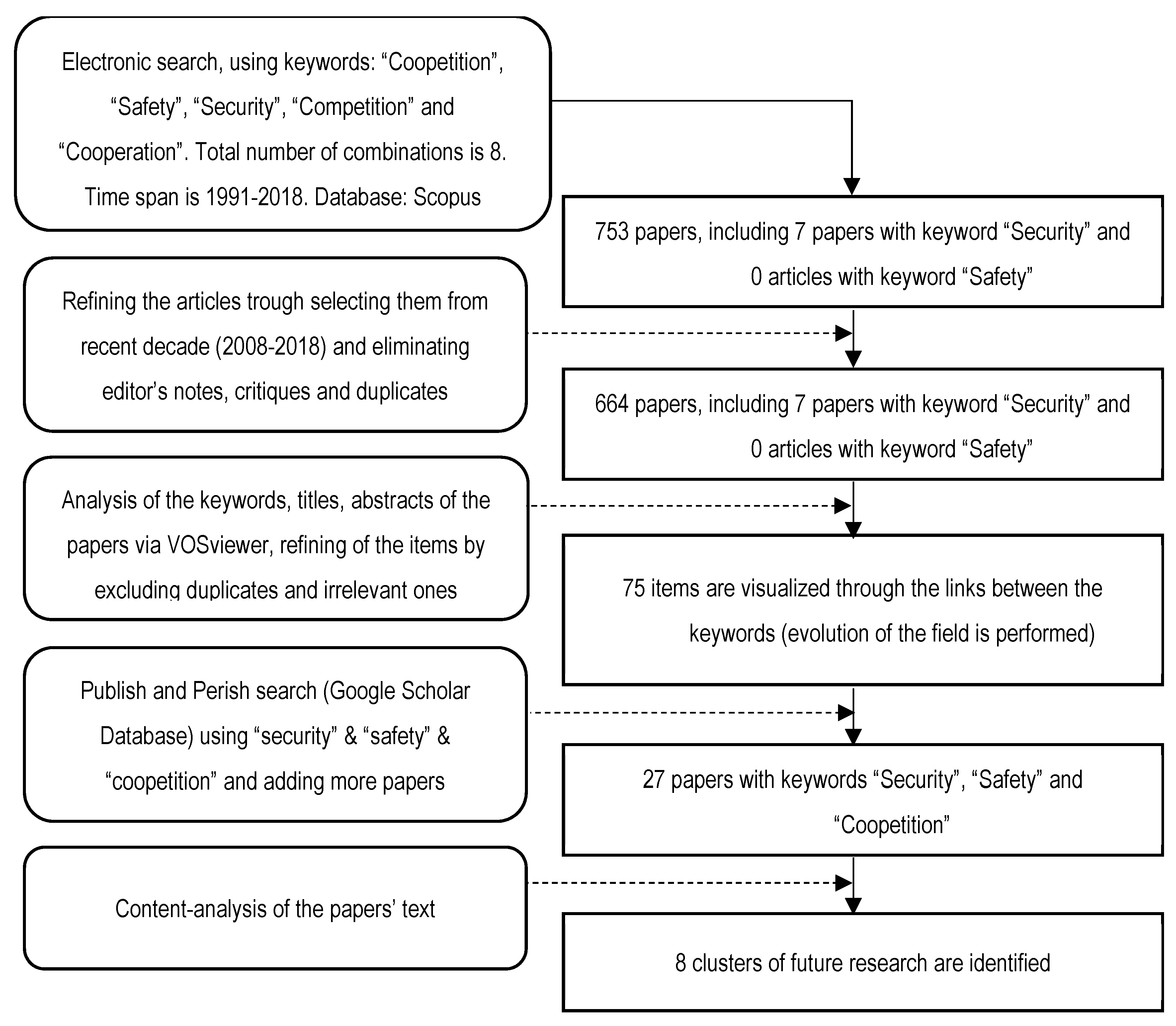
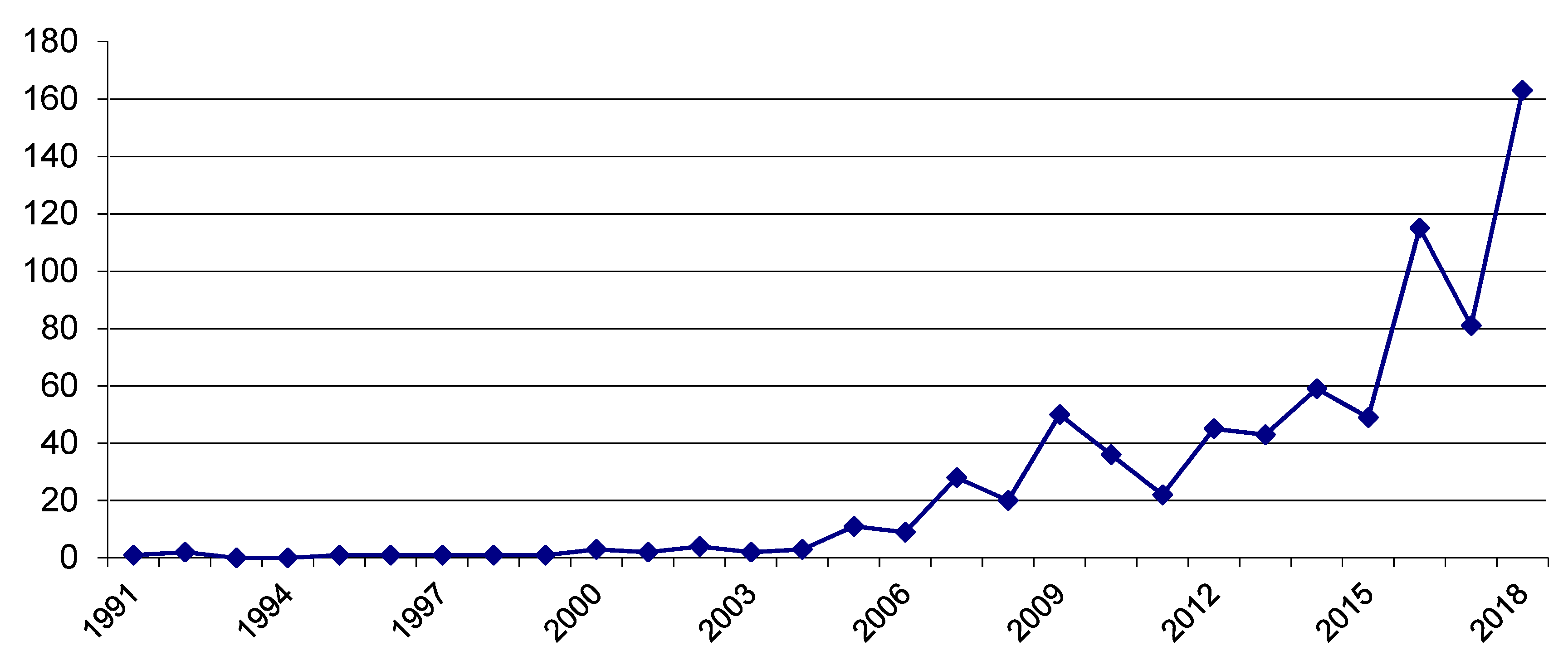
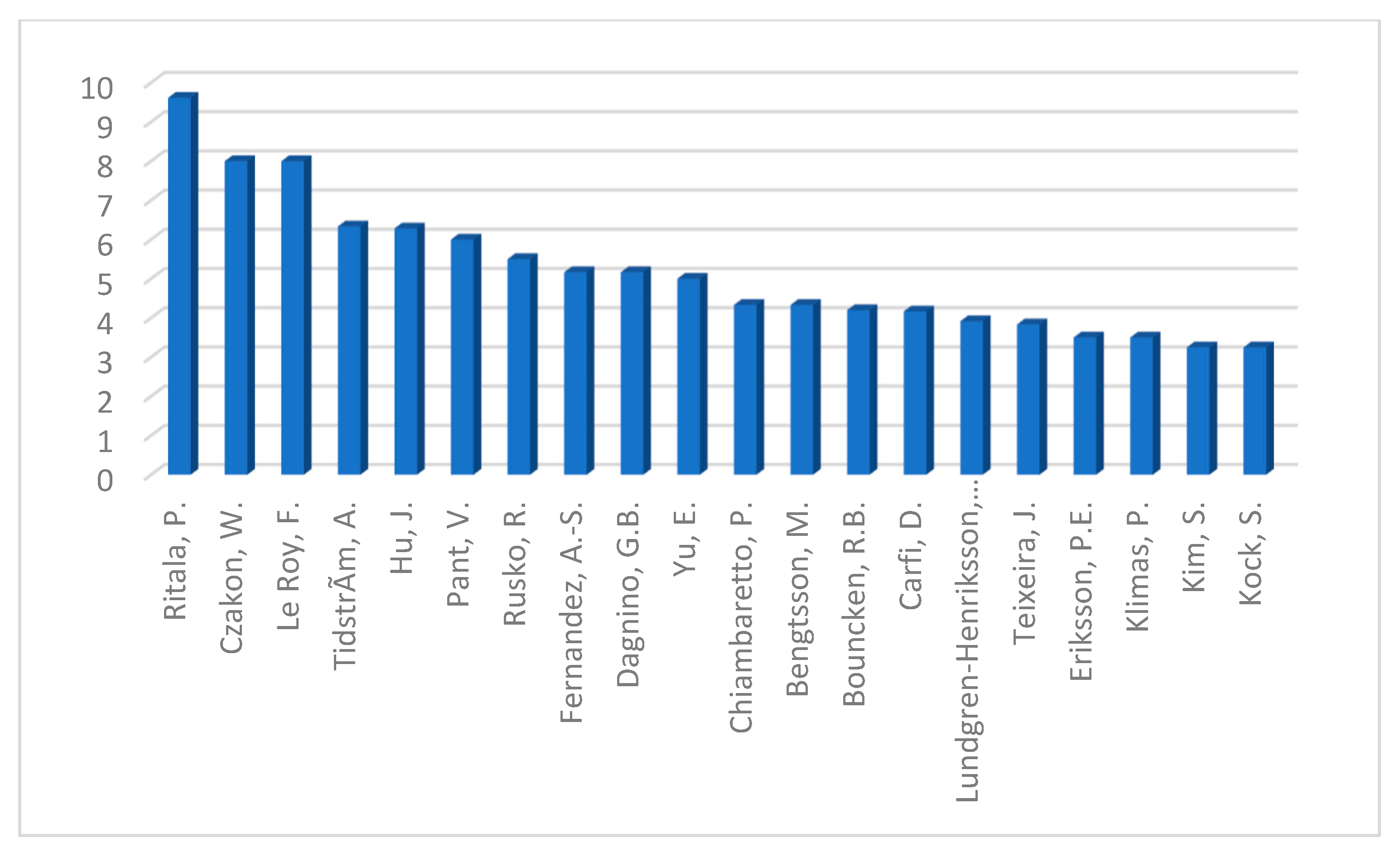


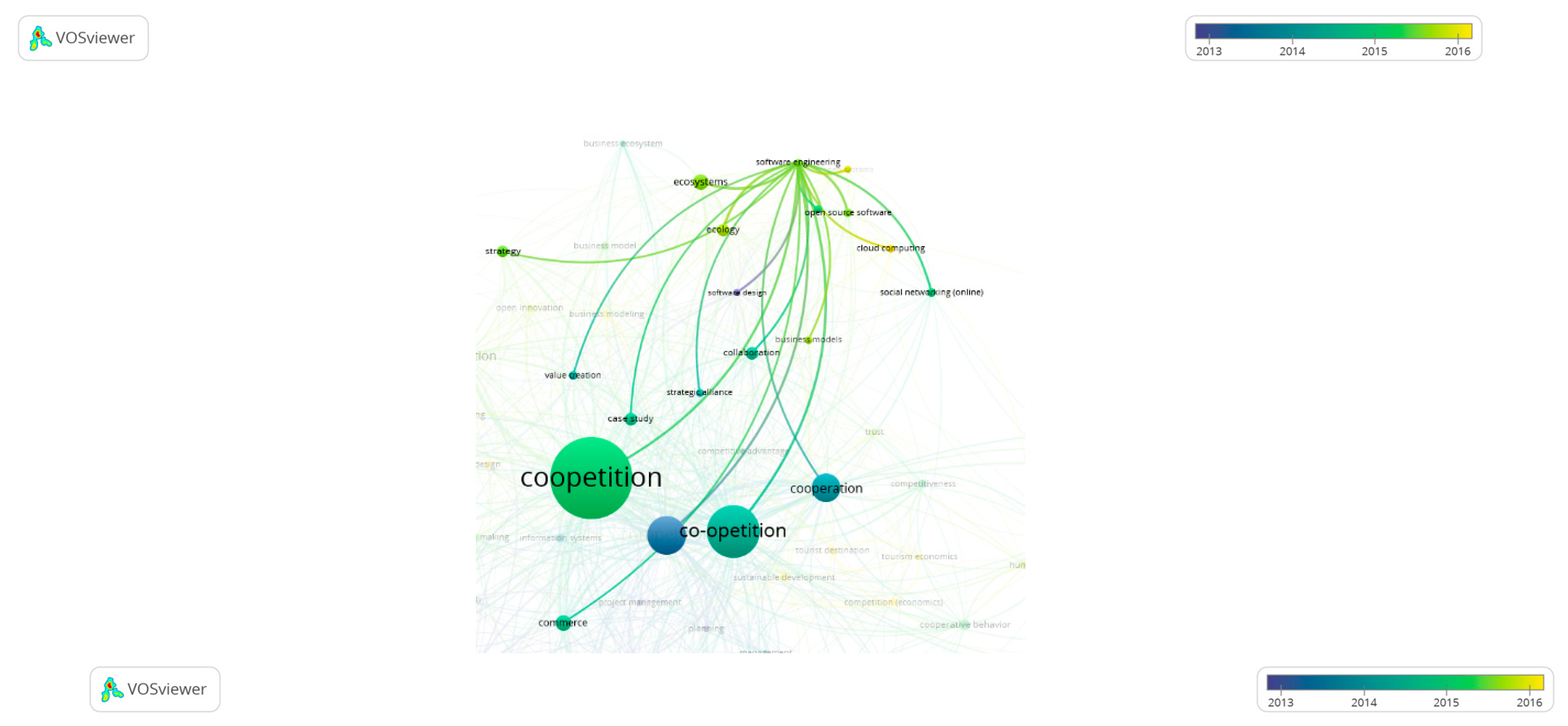
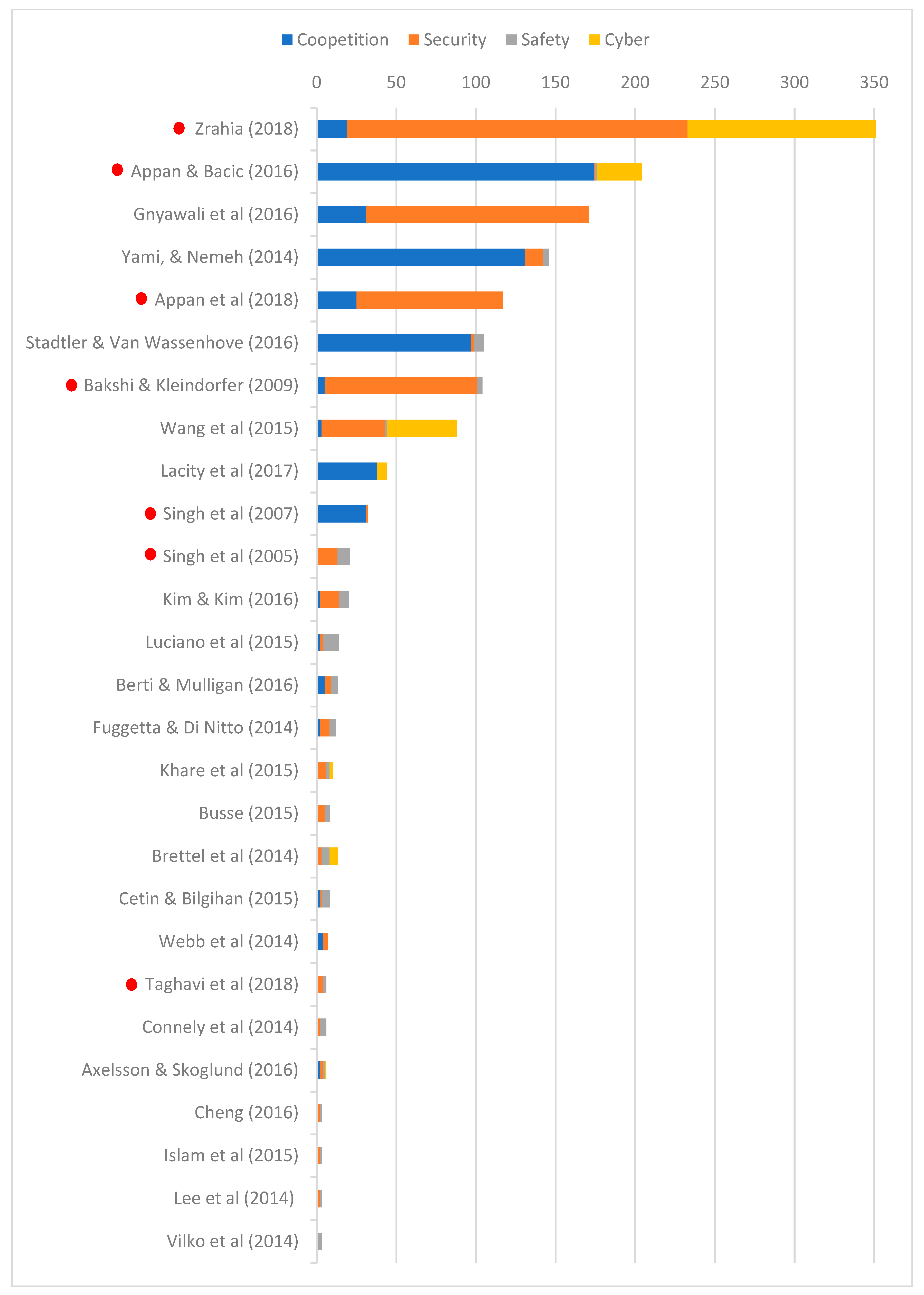
| Search Keywords | No. of Papers |
|---|---|
| cooperation AND safety | 13,787 |
| cooperation AND security | 12,927 |
| cooperation AND security AND safety | 914 |
| coopetition | 753 |
| cooperation AND competition AND safety | 189 |
| cooperation AND competition AND security AND safety | 21 |
| coopetition AND security | 7 * |
| coopetition AND safety | 0 |
| Author/Affiliation | No. of Papers |
|---|---|
| Le Roy, F. (Université de Montpellier, France) | 23 |
| Ritala, P. (Lappeenrannan Teknillinen Yliopisto, Finland) | 21 |
| Czakon, W. (Uniwersytet Jagielloński w Krakowie, Poland) | 15 |
| Dagnino, G.B. (LUMSA University, Italy) | 15 |
| Hu, J. (University of Electronic Science and Technology of China, China) | 15 |
| Bengtsson, M. (Umeå Universitet, Sweden) | 12 |
| Bouncken, R.B. (Universität Bayreuth, Germany) | 12 |
| Fernandez, A.S. (Université de Montpellier, France) | 12 |
| Chiambaretto, P. (Université de Montpellier, Montpellier Business School, France) | 11 |
| Pant, V. (University of Toronto, Canada) | 10 |
| Cluster | Main Idea/Insights | Author(s) |
|---|---|---|
| Industry 4.0. | Solutions for telecommunication sectors, and other end-to-end services such as e-health, e-security, digital homes, digital enterprises and digital cities | Yami & Nemeh (2014) |
| Research streams generalization | Brettel et al. (2014) | |
| Coopetition as a cater for further development in a sphere of Cyber-Physical Systems manufacturing | Wang et al. (2015) | |
| Security Challenges | Kim, S., & Kim, S. (2016) | |
| Cloudchain as a Blockchain-Based Coopetition in a process of data sharing | Taghavi et al. (2018) | |
| Cybersecurity | Open innovations as a strategy for software development | Fuggetta & di Nitto (2013) |
| Quality assurance in software ecosystems through Actors Partnership | Axelsson & Skoglund (2015) | |
| Sharing Paradox; benefits of sharing IT security information | Appan et al. (2018) Appan & Bacic (2016) | |
| New standards for outsourcing contracts for software development, IT service | Lacity et al. (2017) | |
| Solutions for cybersecurity threat-intelligence sharing | Zrahia (2018) | |
| Interactions in multi-sensor environment | Conflict resolution between sensors (cameras) due to coopetition | Singh et al. (2007), Singh & Atrey (2005) |
| Supply chain security management | Benefits of joint investments approach, Superiority of coopetition strategy | Bakshi & Kleindorfer (2009) |
| Multinational corporations management | Technology infrastructure is a moderator of knowledge sharing | Islam et al. (2014) |
| Biomedicine | Crowdsourcing | Khare et al. (2015) |
| Sharing economy in tourism | Cooperation-based destination management; Decentralized system of distributed labour | Cetin, & Bilgihan (2015) |
| Cheng (2016) | ||
| HUBs and start-ups | Value creation through “shared value” towards mutual benefits for all parties | Berti & Mulligan (2016). |
© 2019 by the author. Licensee MDPI, Basel, Switzerland. This article is an open access article distributed under the terms and conditions of the Creative Commons Attribution (CC BY) license (http://creativecommons.org/licenses/by/4.0/).
Share and Cite
Shvindina, H. Coopetition as an Emerging Trend in Research: Perspectives for Safety & Security. Safety 2019, 5, 61. https://0-doi-org.brum.beds.ac.uk/10.3390/safety5030061
Shvindina H. Coopetition as an Emerging Trend in Research: Perspectives for Safety & Security. Safety. 2019; 5(3):61. https://0-doi-org.brum.beds.ac.uk/10.3390/safety5030061
Chicago/Turabian StyleShvindina, Hanna. 2019. "Coopetition as an Emerging Trend in Research: Perspectives for Safety & Security" Safety 5, no. 3: 61. https://0-doi-org.brum.beds.ac.uk/10.3390/safety5030061




